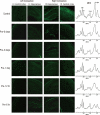Protective effect of hypoxic preconditioning on hypoxic-ischemic injured newborn rats
- PMID: 22065907
- PMCID: PMC3207054
- DOI: 10.3346/jkms.2011.26.11.1495
Protective effect of hypoxic preconditioning on hypoxic-ischemic injured newborn rats
Abstract
Brief episodes of cerebral hypoxia-ischemia cause transient ischemic tolerance to subsequent ischemic events that are otherwise lethal. This study was conducted to evaluate the protective effect of hypoxic preconditioning on hypoxic-ischemic injury in the neonatal rat and the persistence of a protective window after hypoxic preconditioning. The rats were preconditioned with hypoxia (8% oxygen, 92% nitrogen) for three hours, subjected to ischemia using ligation of the right common carotid artery, and then exposed to another three hours of hypoxia. Using proton magnetic resonance spectroscopy, terminal deoxynucleotidyl transferase-mediated dUTP-biotin nick end-labeling (TUNEL) staining, and morphologic scores, this study shows that hypoxic preconditioning 6-hr to 1-day before hypoxic-ischemic injury increases survival rates and has neuroprotective effects against subsequent hypoxic-ischemic injury. The mechanism of the protective effects of hypoxic preconditioning in the newborn rat brain may involve downregulation of apoptotic cell death.
Keywords: Hypoxia-Ischemia, Brain; Magnetic Resonance Spectroscopy.
Figures






Similar articles
-
Similar neuroprotective effects of ischemic and hypoxic preconditioning on hypoxia-ischemia in the neonatal rat: a proton MRS study.Int J Dev Neurosci. 2013 Nov;31(7):616-23. doi: 10.1016/j.ijdevneu.2013.08.001. Epub 2013 Aug 16. Int J Dev Neurosci. 2013. PMID: 23958850
-
The effects of dantrolene on hypoxic-ischemic injury in the neonatal rat brain.Anesth Analg. 2008 Jan;106(1):227-33, table of contents. doi: 10.1213/01.ane.0000287663.81050.38. Anesth Analg. 2008. PMID: 18165582
-
The effect of mitochondrial adenosine triphosphate-sensitive potassium (K(ATP)) channel blocker on ischemic preconditioning in hypoxic-ischemic brain injury model of neonatal rat.Korean J Anesthesiol. 2009 Dec;57(6):729-736. doi: 10.4097/kjae.2009.57.6.729. Korean J Anesthesiol. 2009. PMID: 30625957
-
Neuroprotective effects and mechanisms of ischemic/hypoxic preconditioning on neurological diseases.CNS Neurosci Ther. 2021 Aug;27(8):869-882. doi: 10.1111/cns.13642. CNS Neurosci Ther. 2021. PMID: 34237192 Free PMC article. Review.
-
Preconditioning and postinsult therapies for perinatal hypoxic-ischemic injury at term.Anesthesiology. 2010 Jul;113(1):233-49. doi: 10.1097/ALN.0b013e3181dc1b84. Anesthesiology. 2010. PMID: 20526192 Review.
Cited by
-
The Delay Phenomenon: A Compilation of Knowledge across Specialties.Craniomaxillofac Trauma Reconstr. 2014 Jun;7(2):112-8. doi: 10.1055/s-0034-1371355. Epub 2014 Feb 21. Craniomaxillofac Trauma Reconstr. 2014. PMID: 25071876 Free PMC article. Review.
-
Increased hypoxia-inducible factor 1alpha expression in rat brain tissues in response to aging.Neural Regen Res. 2012 Apr 5;7(10):778-82. doi: 10.3969/j.issn.1673-5374.2012.10.010. Neural Regen Res. 2012. PMID: 25737702 Free PMC article.
-
The investigation of the prenatal and postnatal alcohol exposure-induced neurodegeneration in rat brain: protection by betaine and/or omega-3.Childs Nerv Syst. 2016 Mar;32(3):467-74. doi: 10.1007/s00381-015-2990-1. Epub 2016 Jan 5. Childs Nerv Syst. 2016. PMID: 26732065
-
The fetus at the tipping point: modifying the outcome of fetal asphyxia.J Physiol. 2018 Dec;596(23):5571-5592. doi: 10.1113/JP274949. Epub 2018 Jun 21. J Physiol. 2018. PMID: 29774532 Free PMC article. Review.
References
-
- Pin TW, Eldridge B, Galea MP. A review of developmental outcomes of term infants with post-asphyxia neonatal encephalopathy. Eur J Paediatr Neurol. 2009;13:224–234. - PubMed
-
- Cantagrel S, Krier C, Ducrocq S, Bodard S, Payen V, Laugier J, Guilloteau D, Chalon S. Hypoxic preconditioning reduces apoptosis in a rat model of immature brain hypoxia-ischaemia. Neurosci Lett. 2003;347:106–110. - PubMed
-
- Sanders RD, Manning HJ, Robertson NJ, Ma D, Edwards AD, Hagberg H, Maze M. Preconditioning and postinsult therapies for perinatal hypoxic-ischemic injury at term. Anesthesiology. 2010;113:233–249. - PubMed
-
- Gidday JM, Fitzgibbons JC, Shah AR, Park TS. Neuroprotection from ischemic brain injury by hypoxic preconditioning in the neonatal rat. Neurosci Lett. 1994;168:221–224. - PubMed
Publication types
MeSH terms
Substances
LinkOut - more resources
Full Text Sources

